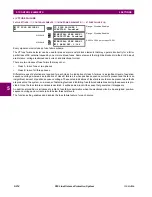
GE Multilin
D30 Line Distance Protection System
5-225
5 SETTINGS
5.8 INPUTS AND OUTPUTS
5
The D30 latching output contacts are mechanically bi-stable and controlled by two separate (open and close) coils. As such
they retain their position even if the relay is not powered up. The relay recognizes all latching output contact cards and pop-
ulates the setting menu accordingly. On power up, the relay reads positions of the latching contacts from the hardware
before executing any other functions of the relay (such as protection and control features or FlexLogic).
The latching output modules, either as a part of the relay or as individual modules, are shipped from the factory with all
latching contacts opened. It is highly recommended to double-check the programming and positions of the latching con-
tacts when replacing a module.
Since the relay asserts the output contact and reads back its position, it is possible to incorporate self-monitoring capabili-
ties for the latching outputs. If any latching outputs exhibits a discrepancy, the
LATCHING OUTPUT ERROR
self-test error is
declared. The error is signaled by the
LATCHING OUT ERROR
FlexLogic operand, event, and target message.
•
OUTPUT H1a OPERATE
: This setting specifies a FlexLogic operand to operate the ‘close coil’ of the contact. The
relay will seal-in this input to safely close the contact. Once the contact is closed and the
RESET
input is logic 0 (off),
any activity of the
OPERATE
input, such as subsequent chattering, will not have any effect. With both the
OPERATE
and
RESET
inputs active (logic 1), the response of the latching contact is specified by the
OUTPUT H1A TYPE
setting.
•
OUTPUT H1a RESET
: This setting specifies a FlexLogic operand to operate the ‘trip coil’ of the contact. The relay will
seal-in this input to safely open the contact. Once the contact is opened and the
OPERATE
input is logic 0 (off), any
activity of the
RESET
input, such as subsequent chattering, will not have any effect. With both the
OPERATE
and
RESET
inputs active (logic 1), the response of the latching contact is specified by the
OUTPUT H1A TYPE
setting.
•
OUTPUT H1a TYPE
: This setting specifies the contact response under conflicting control inputs; that is, when both the
OPERATE
and
RESET
signals are applied. With both control inputs applied simultaneously, the contact will close if set to
“Operate-dominant” and will open if set to “Reset-dominant”.
Application Example 1:
A latching output contact H1a is to be controlled from two user-programmable pushbuttons (buttons number 1 and 2). The
following settings should be applied.
Program the Latching Outputs by making the following changes in the
SETTINGS
INPUTS/OUTPUTS
CONTACT OUT-
PUTS
CONTACT OUTPUT H1a
menu (assuming an H4L module):
OUTPUT H1a OPERATE:
“
PUSHBUTTON 1 ON
”
OUTPUT H1a RESET:
“
PUSHBUTTON 2 ON
”
Program the pushbuttons by making the following changes in the
PRODUCT SETUP
USER-PROGRAMMABLE PUSHBUT-
TONS
USER PUSHBUTTON 1
and
USER PUSHBUTTON 2
menus:
PUSHBUTTON 1 FUNCTION:
“Self-reset”
PUSHBUTTON 2 FUNCTION:
“Self-reset”
PUSHBTN 1 DROP-OUT TIME:
“0.00 s”
PUSHBTN 2 DROP-OUT TIME:
“0.00 s”
Application Example 2:
A relay, having two latching contacts H1a and H1c, is to be programmed. The H1a contact is to be a Type-a contact, while
the H1c contact is to be a Type-b contact (Type-a means closed after exercising the operate input; Type-b means closed
after exercising the reset input). The relay is to be controlled from virtual outputs: VO1 to operate and VO2 to reset.
Program the Latching Outputs by making the following changes in the
SETTINGS
INPUTS/OUTPUTS
CONTACT OUT-
PUTS
CONTACT OUTPUT H1a
and
CONTACT OUTPUT H1c
menus (assuming an H4L module):
OUTPUT H1a OPERATE:
“VO1”
OUTPUT H1c OPERATE:
“VO2”
OUTPUT H1a RESET:
“VO2”
OUTPUT H1c RESET:
“VO1”
Since the two physical contacts in this example are mechanically separated and have individual control inputs, they will not
operate at exactly the same time. A discrepancy in the range of a fraction of a maximum operating time may occur. There-
fore, a pair of contacts programmed to be a multi-contact relay will not guarantee any specific sequence of operation (such
as make before break). If required, the sequence of operation must be programmed explicitly by delaying some of the con-
trol inputs as shown in the next application example.
Application Example 3:
A make before break functionality must be added to the preceding example. An overlap of 20 ms is required to implement
this functionality as described below:
Summary of Contents for D30D00HCHF8AH6AM6BP8BX7A
Page 10: ...x D30 Line Distance Protection System GE Multilin TABLE OF CONTENTS...
Page 374: ...5 248 D30 Line Distance Protection System GE Multilin 5 10 TESTING 5 SETTINGS 5...
Page 398: ...6 24 D30 Line Distance Protection System GE Multilin 6 5 PRODUCT INFORMATION 6 ACTUAL VALUES 6...
Page 410: ...7 12 D30 Line Distance Protection System GE Multilin 7 2 TARGETS 7 COMMANDS AND TARGETS 7...
Page 444: ...9 24 D30 Line Distance Protection System GE Multilin 9 5 FAULT LOCATOR 9 THEORY OF OPERATION 9...
Page 576: ...B 102 D30 Line Distance Protection System GE Multilin B 4 MEMORY MAPPING APPENDIX B B...
Page 616: ...D 10 D30 Line Distance Protection System GE Multilin D 1 IEC 60870 5 104 PROTOCOL APPENDIX D D...
Page 628: ...E 12 D30 Line Distance Protection System GE Multilin E 2 DNP POINT LISTS APPENDIX E E...
Page 636: ...F 8 D30 Line Distance Protection System GE Multilin F 3 WARRANTY APPENDIX F F...
Page 646: ...x D30 Line Distance Protection System GE Multilin INDEX...
















































